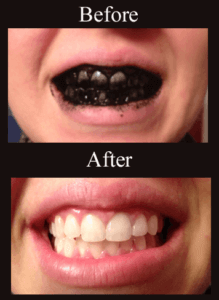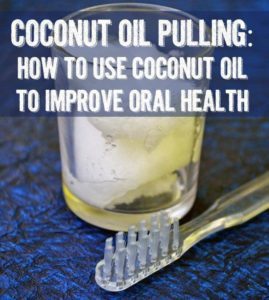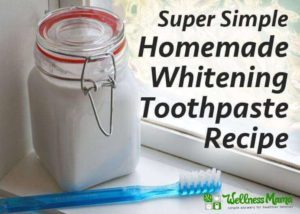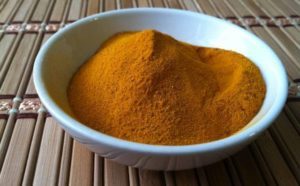4 Natural Teeth Whitening Options That Work (original) (raw)
Teeth whitening is a multi-billion dollar industry, but unfortunately many teeth whitening treatments contain harsh chemicals that can leave teeth feeling sensitive for a long time. I had sensitive teeth for years after my high school attempts at teeth whitening (at home and at the dentist office).
Once I became pregnant with our first child, I was careful to avoid all chemicals, including those normally used to whiten teeth. I wanted to find natural ways to whiten my teeth that not only worked well, but were also safe. Since chemicals can easily absorb through the sensitive skin in the mouth, I wanted to only use options that were safe enough to eat.
Of course, none of these things are a replacement for normal dental care and I asked my dentist before using these (you should too!). I’ve found that these methods work great along side my normal brushing and flossing routine.
1. Charcoal
 My first and favorite teeth whitening remedy is also the most controversial: Activated Charcoal.
My first and favorite teeth whitening remedy is also the most controversial: Activated Charcoal.
This was recommended to me by a holistic dentist years ago and though I was skeptical at first, I gave it a try and have been impressed with the results over time.
Yes, it looks terrifying while you are doing it and you will absolutely think for a minute that you were duped by a blogger into permanently staining your teeth. Then, you’ll rinse your mouth and brush as usual and notice that your teeth are not only white again, but possibly whiter.
This works because activated charcoal is a highly absorbent porous substance that binds to things like tannins that stain teeth and leave them yellow or brown. It might also have other benefits for the mouth as well:
Further research I’ve done on this showed that activated charcoal can actually be helpful in changing the pH and health of the mouth, and as such is effective in avoiding cavities and killing the bad bacteria present in tooth decay and gingivitis. For this reason, I now suggest and use it as part of my remineralizing protocol for teeth, along with my remineralizing toothpaste.
When I first wrote about this in 2012, it was controversial and I actually got hate mail (really) for trying to convince people to do something that was obviously going to stain their teeth. These days, I see pictures of it floating around Pinterest, so it seems to have gained a little acceptance.
Some important things I’ve discovered over the years:
- Keep a microfiber cloth on hand to make cleanup easy as it can make a mess on counters and sinks (though it will come out of them as well)
- I simply dip my toothbrush into some powdered charcoal that I keep in a small jar on my counter and brush as normal. Another way that will produce results more quickly is to mix a teaspoon of charcoal powder into some water and swish with it for a few minutes. Then, spit the water and leave the remaining charcoal in the mouth for a few minutes so that it has time to bind to stains.
- It is super important to use activated charcoal from a food/medical grade source. This is not the same as charcoal from your BBQ grill…do not use that.
- I did this every day for a week when I started and now maintain by using it once a week or so.
- I felt comfortable brushing with charcoal during pregnancy since oral health is even more important then, and it is spit out and not consumed. I checked with my midwife first (and you should too if pregnant).
Full tutorial and video are here. Now I just use my Wellnesse Charcoal Toothpaste!
p.s. If you want to take it up a notch, I’ve since discovered this teeth whitening system that uses activated charcoal and LED light for maximum whitening and love the results. It’s also less messy than the above… bonus!
2. Oil Pulling
 Another oddly controversial teeth whitener: oil pulling.
Another oddly controversial teeth whitener: oil pulling.
The basic concept here is swishing oil (like sesame or coconut) in the mouth for 20 minutes to help remove plaque and bacteria from the mouth. Coconut oil has been proven effective against the streptococcus mutans bacteria that contributes to cavities and gum disease.
Since beginning oil pulling on a regular basis, I’ve noticed that my teeth are smooth and shiny and the dental assistants have commented that I had very little plaque at recent cleanings.
What to do: Swish with a small amount of coconut oil for 20 minutes a day, preferably first thing in the morning before eating. I make single use size coconut oil pulling chews to make this even easier and do this while showering.
Here is the oil pulling tutorial and this post specifically addresses using coconut oil.
3. Whitening Toothpaste
 Last year, I combined a few of my favorite teeth whitening ingredients to make a homemade whitening toothpaste. It only contains:
Last year, I combined a few of my favorite teeth whitening ingredients to make a homemade whitening toothpaste. It only contains:
- Pure Calcium Carbonate Powder
- Non-GMO Xylitol Powder
- MCT oil (I’ve also used this less expensive one with good results) or coconut oil
This combines natural calcium (a mineral that teeth need) with Xylitol, which is helpful for oral health, and MCT or coconut oil for a remineralizing, bacteria fighting whitening toothpaste.
4. Turmeric
 Another counter-intuitive remedy that actually works. Turmeric is known for staining things yellow (including cloth, skin and other surfaces) and it has even been used as a dye for cloth in the past. It isn’t the first thing you’d think of for whitening teeth, but it works surprisingly well.
Another counter-intuitive remedy that actually works. Turmeric is known for staining things yellow (including cloth, skin and other surfaces) and it has even been used as a dye for cloth in the past. It isn’t the first thing you’d think of for whitening teeth, but it works surprisingly well.
Mommypotamus explains why and provides a tutorial here.
This article was medically reviewed by Dr. Steven Lin, who is a Board accredited dentist trained at the University of Sydney. With a background in biomedical science, he is a passionate whole-health advocate, focusing on the link between nutrition and dental health. As always, this is not personal medical advice and we recommend that you talk with your doctor or dentist.
Ever whitened your teeth? Naturally or not so much? Did it work?